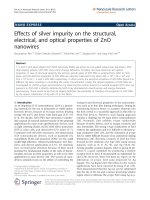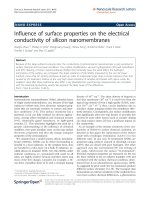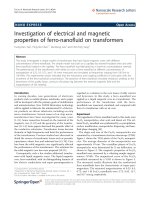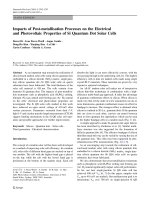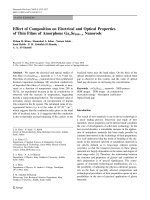Báo cáo hóa học: " Department of Electrical & Computer Engineering" pptx
Bạn đang xem bản rút gọn của tài liệu. Xem và tải ngay bản đầy đủ của tài liệu tại đây (566.93 KB, 2 trang )
EURASIP Journal on Wireless Communications and Networking 2004:2, 199–200
c
2004 Hindawi Publishing Corporation
Editorial
A. Lee Swindlehurst
Department of Electrical & Computer Engineering, Brigham Young University, Provo, UT 84604, USA
Email:
Robert F. H. Fischer
Lehrstuhl f
¨
ur Informations
¨
ubertragung, Universit
¨
at Erlangen-N
¨
urnberg, 91058 Erlangen, Germany
Email: fi
Brian M. Sadler
US Army Research Laboratory, Adelphi, MD 20783, USA
Email:
There has been an explosion of research interest during the
past decade in multiantenna wireless communications sys-
tems due to their promise for increased throughput and
reliability. Initial work on these multiple-input multiple-
output (MIMO) systems focused on single-user, point-to-
point links, where interference is modeled generically and
resource allocation issues can be ignored. More recently,
increased attention has been given to multiuser problems,
where one or more network nodes possess multiple anten-
nas. This represents a generalized MIMO problem, where
the multiple inputs could be from an antenna array at a sin-
gle location, from single antennas at different locations, or
from multiple antenna arrays at multiple points. Similarly,
the multiple outputs could be arranged in any of these con-
figurations as well. Once the spatial resources of the chan-
nel must be shared among several users, issues such as in-
terference cancellation, power allocation, scheduling, source
separation, and multiuser detection arise. The interplay of
these problems with standard MIMO topics such as space-
time coding , beamforming, channel estimation, and capac-
ity provide for an extremely rich array of research direc-
tions.
The papers that appear in this special issue reflect the
variety of problems that must be addressed in a multiuser
MIMO communications network. The first three papers
(Popescu and Rose, Pascual-Iserte et al., Zhang and Dai)
address system-level optimization when channel state in-
formation (CSI) is available at all points in the network.
Maximizing or achieving a minimum acceptable signal-
to-interference-plus-noise ratio (SINR) for every network
link is shown to require proper coordination of transmit-
ted power and joint transmit/receive beamformer design.
The next three papers (Spencer and Swindlehurst, Pan et
al., Biguesh et al.) are similar in spirit, but specifically fo-
cus on the downlink problem, where one or more base sta-
tions attempt to simultaneously communicate with multiple
cochannel users. Again, power control and joint beamformer
design are the keys. At this point, the special issue shifts to
considerations of the capacity of the multiuser uplink. Jor-
swieck and Boche study capacity under various worst-case
assumptions on the noise, and develop corresponding op-
timal uplink transmit strategies. Serbetli and Yener investi-
gate approaches for scheduling uplink transmissions and up-
link transmit beamformer design in order to maximize the
sum capacity. H
¨
am
¨
al
¨
ainen et al. discuss the coverage and ca-
pacity gains of multiuser MIMO techniques for the specific
case of UMTS terrestrial radio access systems. Veselinovic
et al. report on the application of turbo equalization and
multiuser detection techniques for uplink user signal sepa-
ration. Finally, all of the above papers assume the availability
of CSI, but they do not discuss how this is to be achieved.
This very important problem is the topic of the paper by
Sung et al., which describes how to exploit the structure of
space-time encoded CDMA signals for blind channel estima-
tion.
We would like to thank the many individuals who par-
ticipated in the review process of this special issue; their ef-
forts have led to considerable refinement of the papers and
to greatly improving the issue’s overall quality. We appreci-
ate the efforts of the authors not only in producing inter-
esting and informative papers, but also in keeping up with
our submission and revision timeline. Finally, we express
200 EURASIP Journal on Wireless Communications and Networking
appreciation to Hindawi Publishing for their support in
helping to make this special issue a reality. Ultimately, we
hope that the papers and references listed in this special is-
sue will spark continued interest in what is a very exciting
research area.
A. Lee Swindlehurst
Robert F. H. Fischer
Brian M. Sadle r
A. Lee Swindlehurst received the B.S. and
M.S. degrees in electrical engineering from
Brigham Young University (BYU) in 1985
and 1986, respectively, and the Ph.D. de-
gree in electrical engineering from Stanford
University in 1991. From 1986 till 1990,
he was employed at ESL, Inc., Sunnyvale,
Calif, where he worked on the design of
algorithms and architectures for radar and
sonar signal processing systems. He joined
the faculty of the Department of E lectrical and Computer Engi-
neering, BYU, in 1990, where he is a Full Professor and is currently
serving as Department Chair. During 1996–1997, he was a Visiting
Scholar at both Uppsala University and the Royal Institute of Tech-
nology, Sweden. His research interests lie primarily in the applica-
tion of sensor array signal processing to radar and wireless commu-
nications problems. Dr. Swindlehurst is a Fellow of the IEEE, is cur-
rently serving as a Member of the Editorial Board for the EURASIP
Journal on Wireless Communications and Networking, and is a for-
mer Associate Editor for the IEEE Transactions on Signal Process-
ing. He is a recipient of the 2000 IEEE W.R.G. Baker Prize Paper
Award, and is the coauthor of a paper that received the IEEE Signal
Processing Society Young Author Best Paper Award in 2001.
Robert F. H. Fischer received the Dr Ing.
degree in 1996, and the Habilitation degree
in 2001, all from the University of Erlangen-
N
¨
urnberg, Erlangen, Germany. The sub-
ject of his dissertation was multichannel
and multicarrier modulation, and that of
his habilitation was precoding and sig-
nal shaping. Form 1992 to 1996, he was
a Research Assistant at the Telecommuni-
cations Institute, University of Erlangen-
N
¨
urnberg. During 1997, he was with the IBM Research Labora-
tory, Z
¨
urich, Switzerland. In 1998, he returned to the Telecom-
munications Institute II, University of Erlangen-N
¨
urnberg. Cur-
rently, he teaches graduate courses in digital communications.
His research concentrates on fast digital transmission including
single- and multicarrier modulation techniques. His current in-
terests are in information theor y, coded modulation, digital com-
munications and signal processing, and especially precoding and
shaping techniques for high-r a te transmission schemes. Dr. Fis-
cher received the Dissertation Award from the Faculty of Engi-
neering, University of Erlangen-N
¨
urnberg, in 1997, the Publica-
tion Award of the German Society of Information Techniques
(ITG) in 2000, and the Wolfgang-Finkelnburg Habilitation Award
in 2002. He is the author of the textbook Precoding and Signal
Shaping for Digital Transmission (John Wiley & Sons, New York,
2002).
Brian M. Sadler received the B.S. and M.S.
degrees from the University of Maryland,
College Park, and the Ph.D. degree from the
University of Virginia, Charlottesville, all in
electrical engineering. He is a Senior Re-
search Scientist at the Army Research Lab-
orator y (ARL), Adelphi, Md. He was a lec-
turer at the University of Maryland, and has
been lecturing at Johns Hopkins University
since 1994 on statistical signal processing
and communications. He was an Associate Editor for the IEEE
Transactions on Signal Processing, is on the Editorial Board for the
EURASIP Journal on Wireless Communications and Networking,
and is a Guest Editor for the IEEE JSAC special issue on military
communications. He is a Member of the IEEE Technical Commit-
tee on Signal Processing for Communications, and cochaired the
2nd IEEE Workshop on Signal Processing Advances in Wireless
Communications (SPAWC-99). His research interests include sig-
nal processing for mobile wireless and ultra-wideband systems, and
sensor signal processing and n etworking.

